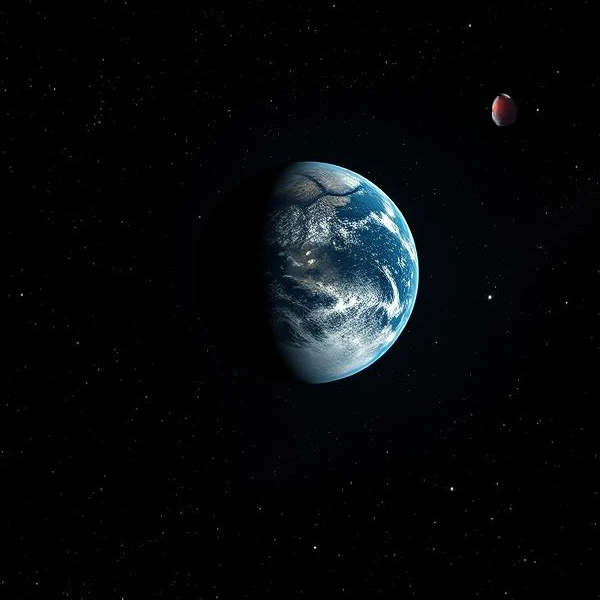
The small asteroid 2009 DD45, discovered in February 2009, belongs to the Apollo family. Its diameter is estimated between 30 and 40 meters and its mass could reach 1 × 108 kg. This type of celestial body is classified as a near-Earth object because it crosses Earth's orbit. On March 2, 2009, it passed only 63,500 km from Earth, or one-fifth the distance between Earth and the Moon. The probability that an asteroid of this size will strike Earth in a given year is estimated at about 1 in 1,000 to 1 in 5,000, which remains low but not negligible over long timescales.
N.B.:
The Apollos are a family of near-Earth asteroids characterized by a semi-major axis greater than 1 AU and a perihelion less than 1.017 AU (Earth's distance from the Sun varies between 0.983 AU and 1.017 AU). This means their orbit crosses that of Earth, making them potentially dangerous in case of spatial-temporal coincidence. The Apollos include several notable objects such as (1862) Apollo, which gave its name to the group, (4179) Toutatis, (6489) Golevka, and (99942) Apophis, whose close approach in 2029 is particularly studied.
NEAs (Near-Earth Asteroids) are classified into four main families according to their orbits:
This classification helps assess their potential danger to our planet and prioritize astronomical monitoring.
| Name / Designation | Estimated Diameter | Minimum Approach Distance | Notable Passage Date | NEA Type | Comment |
|---|---|---|---|---|---|
| (3200) Phaethon | 5.8 km | 10.4 million km | 2017 | Apollo | Parent body of the Geminid meteor shower |
| (2062) Atira | 5 km | 16.6 million km | 2018 | Atira | Asteroid with an orbit entirely inside Earth's |
| (4179) Toutatis | 2.7 km | 1.55 million km | 2012 | Apollo | Asteroid with chaotic motion, flown by the Chang’e 2 probe |
| (7335) 1989 JA | 1.8 km | 4 million km | 2022 | Apollo | Considered potentially hazardous by NASA |
| (1862) Apollo | 1.45 km | 1.5 million km | 1983 | Apollo | Discovered in 1932, it gave its name to the Apollo family |
| (6489) Golevka | 0.53 km | 4.6 million km | 1995 | Apollo | First asteroid for which the Yarkovsky effect was measured |
| (101955) Bennu | 500 m | 300,000 km (future projections) | 2135 | Apollo | Target of the OSIRIS-REx mission, long-term impact risk studied |
| (454100) 2013 BO73 | ~500 m | 2.9 million km | 2016 | Apollo | Large Apollo monitored, orbit close to Earth's |
| (99942) Apophis | ~370 m | 31,000 km | 2029 | Apollo | Extremely close approach, below the orbit of geostationary satellites |
| (3361) Orpheus | ~300 m | 2.8 million km | 1982 | Apollo | Classified as potentially hazardous (PHA) |
| 2009 DD45 | 30–40 m | 63,500 km | 2009 | Apollo | Passed only 1/5 of the Earth-Moon distance |
The kinetic energy of a small object ~35 m in diameter is given by the formula E = ½ m v². Assuming an average density of 3000 kg/m³ and an approach speed of 20 km/s, the asteroid's mass is about 6.7 × 107 kg. The energy released in case of impact would reach about 3.2 megatons of TNT, or about 70 times the energy of the Hiroshima bomb.
N.B.:
Scientists, engineers, and media use this unit (megatons of TNT) to report the potential danger of an impact to decision-makers or the general public. This allows comparison of natural impact vs human energy (weapons, industrial explosions).
An atmospheric impact could cause an airburst, dispersing the energy as a destructive shockwave over several hundred kilometers. If the impact occurred at sea, a regional tsunami would be likely. On land, the shockwave and fireball would have effects comparable to a strategic nuclear weapon.
| Scenario | Main Effect | Affected Area | Comment |
|---|---|---|---|
| Atmospheric airburst | Shockwave | Radius of 100 to 200 km | Comparable to Tunguska (1908) |
| Oceanic impact | Tsunami | Regional coasts | Amplitude of several tens of meters locally |
| Land impact | Cratering + shockwave | Impact zone + local atmosphere | Destruction equivalent to a major nuclear weapon |
Source: NASA CNEOS – Center for Near Earth Object Studies, ESA NEO Coordination Centre.